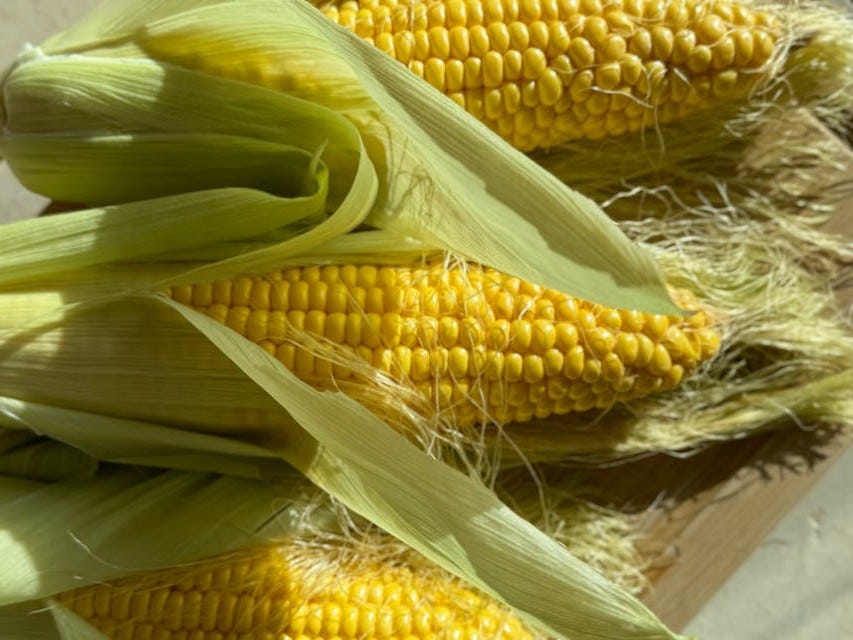After eating Meghan Markle's popcorn corn on the cob, use remaining cobs for plants
Don't throw away corn on the cob if you have a garden

I neither know nor care enough to find out why “With Love, Meghan” has a 3.1-star rating on IMDB. What I do know is my mind was blown when the Duchess of Sussex made popcorn out of corn on the cob. How I never knew this is beyond me.
Recommended Read: “Making a Round-To-It version of Meghan Markle's dog treats ~ Even without all the ingredients, my first time baking dog treats was a win”
Owning a home where I’m never without candles or corn, Episode 1 of “With Love, Meghan” made me scramble to take hosting notes on everything. The only problem with her corn on the cob trick is I like eating corn directly on the cob too much to pop it. Corn kernels don’t stand a chance in my home for long either. With nutritional yeast and Morton Lite Salt nearby, I air-pop the whole container within a week or two — with Junee, my Hound mix, pacing behind me to see if I “accidentally” dropped a few pieces on the floor.
ADVERTISEMENT ~ Amazon
As an Amazon affiliate, I do earn a percentage from each sale while using my referral links.

ADVERTISEMENT ~ Amazon
As an Amazon affiliate, I do earn a percentage from each sale while using my referral links.

Regardless of whether you make popcorn in an air popper, stove popper or microwave popper, you may want to try Meghan Markle’s corn on the cob trick in an oven just one time to explore the differences. But after I eat the corn, I have always ditched the cobs — until I realized there are other uses for them:
Compost material to structure the rest of the biodegradable food
Natural fire starter in an outdoor grill or fireplace
Bird feeder for do-it-yourself crafts
Corn cob jelly (boil and extract the “jelly” juice)
Garden mulch
While I don’t have much interest in the middle three (unless I randomly go back to my Girl Scout camping days as a leader), the first one and the fifth one made me do a double take. I had no idea that corn cobs could be used in your garden or on house plants. How?
Recommended Read: “Meghan Markle's Focaccia bread versus Nard Dog Cooks' vegan rolls: Which is better? ~ Testing whether six-ingredient rosemary bread outranks seven-ingredient, plant-based rolls”
Using corn cobs on houseplants
While it takes corn cobs much longer than other fruits and vegetables to break down in compost, there are quicker ways to use them sooner.
Shred or chop dried corn cobs as a natural mulch.
Boil corn cobs to make a nutrient-infused water for houseplants.
Create biochar, a carbon-rich material that improves soil fertility, out of them.
Use the cob as an outdoor garden stake for younger plants or seedlings so they don’t topple over.
Insert a dried cob at the bottom of a large indoor plant to improve drainage.
ADVERTISEMENT ~ Amazon
As an Amazon affiliate, I do earn a percentage from each sale while using my referral links.

Breaking down how to make biochar from corn cobs
Supplies
Corn cob
Fire pit, barrel or kiln
Shovel or rake
Pitcher of water
Instructions
Make sure the dry cobs are free of contaminants.
If using a fire pit, dig a cone-shaped hole to control the burn. For a barrel or kiln, ensure it has a lid or vents to limit oxygen flow.
Light the biomass from the top to control the burn, allowing the corn cob to char rather than fully combust.
Monitor the fire to ensure it doesn't burn to ash.
Once the corn cob is blackened but not reduced to ash, extinguish the fire by dousing it with water or covering it with soil.
Break the biochar into smaller pieces.
Mix it with compost or nutrient-rich water. This step ensures the biochar doesn't deplete nutrients from your soil.
Mix the activated biochar into your garden soil.
Recommended Read: “Why the Whitley Gilberts and Meghan Markles are threatening to racists ~ Yes, you are about 99% likely to be racist if you hate 'With Love, Meghan”
ADVERTISEMENT ~ Amazon
As an Amazon affiliate, I earn a percentage from purchases with my referral links. I know some consumers are choosing to boycott Amazon for its DEI removal. However, after thinking about this thoroughly, I choose to continue promoting intriguing products from small businesses, women-owned businesses and (specifically) Black-owned businesses who still feature their items on Amazon. All five of my Substack publications now include a MINIMUM of one product sold by a Black-owned business. (I have visited the seller’s official site, not just the Amazon Black-owned logo, to verify this.) If you still choose to boycott, I 100% respect that decision.

Breaking down corn cobs in indoor houseplants
To make sure the corn cob is totally dried out, place it in a warm, dry place for a few days to remove any remaining moisture. Once it’s dry, your houseplant is ready for a roommate.
Use a saw, garden shears, or a sturdy knife to cut the dried corn cob into 1-2-inch chunks.
In a clean pot that has drainage holes at the bottom, place the corn cob pieces at the bottom of the pot, covering the drainage holes but leaving enough space for water to flow through.
Fill the pot halfway with potting soil on top of the corn cob layer.
Position your plant in the pot.
Add more soil to cover the roots.
Water the plant lightly. Make sure excess water drains properly.
Recommended Read: “10 irrational gardening thoughts ~ Unsolicited facts from my social isolation gardening days”
Corn isn’t just amazing as a fiber-rich vegetable (one cup equals 4.6 grams), Vitamin C (17% of the daily value), magnesium (11% of the DV) and potassium (10% of the DV). It turns out it’s a snack for you, your plants and the dog* too. The next time you have guests over, be sure to test Meghan Markle’s popcorn and other hosting tips from “With Love, Meghan” and don’t be surprised when your plants get new compliments.
* It is unsafe to allow your dog to gnaw or eat a corn cob. The cob is not digestible and can cause choking or digestive tract blockage. Dogs can, however, eat popcorn in moderation — no butter, no salt, no partially popped kernels.
Did you enjoy this post? You’re also welcome to check out my Substack columns “Black Girl In a Doggone World,” “BlackTechLogy,” “Homegrown Tales,” “I Do See Color,” “One Black Woman’s Vote” and “Window Shopping” too. Subscribe to this newsletter for the now-weekly paid posts each Friday (as of March 16, 2025). Thanks for reading!




